Gigabyte Z77X-UP7 Review: OC Oriented Orange Overkill
by Ian Cutress on March 1, 2013 10:30 AM EST- Posted in
- Motherboards
- Intel
- Gigabyte
- Z77
Dealing with PLX 8747 Chips and PCIe Lane Layouts
The Z77 chipset specification allows Ivy Bridge CPUs to utilize the 16 PCIe 3.0 lanes in very specific layouts – x16, x8/x8, or x8/x4/x4. In order to do anything else (including 4-way), we have to put in a PCIe 3.0 switch – and the one in use on motherboards that want this functionality is the PLX 8747, which we covered in great detail back in August 2012. The upside of this chip is that for 8 or 16 lanes in, we get 32 lanes out, which can be distributed however the motherboard manufacturer wants. The downside of using this chip however is a small amount of overhead, causing a minor drop in frame rates. For the Gigabyte Z77X-UP7, we get the following configuration:
The UP7 involves a switch which allows the user to have access to a single PCIe 3.0 x16 slot without even touching the PLX chip. However the moment the user wants to add in another card, we can migrate to the orange slots via the PLX chip and maximize the bandwidth it offers. This gives five different configurations:
One card: x16 or x16 via PLX
Two card: x16/x16 via PLX
Three card: x8/x8/x16 via PLX
Four card: x8/x8/x8/x8
In this review I used the opportunity to look at our normal benchmark suite and see how much overhead the PLX chip actually affords to the motherboards that use it.
Metro2033
Metro2033 is a DX11 benchmark that challenges every system that tries to run it at any high-end settings. Developed by 4A Games and released in March 2010, we use the inbuilt DirectX 11 Frontline benchmark to test the hardware at 2560x1440 with full graphical settings. Results are given as the average frame rate from 4 runs.
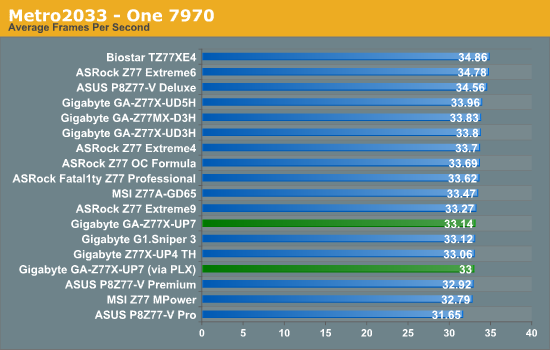
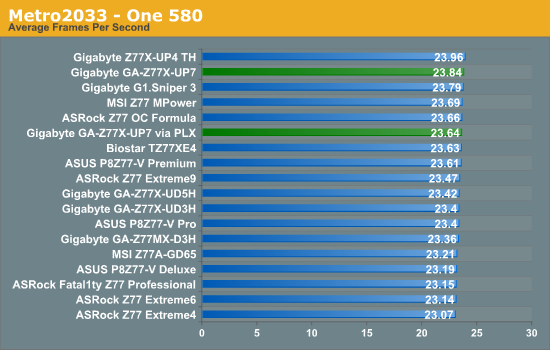
On the PLX front, the chip reduced the single AMD frame rate from 33.14 FPS to 33.00 FPS, a 0.415% decrease. On the NVIDIA side, it reduced our frame rate from 23.84 FPS to 23.64 FPS, a 0.839% decrease. Both of these are nothing much to shout about, especially given the previous NF200 on X58 was a decrease of ~2% performance. Compared to other Z77 motherboards, the UP7 takes advantage of the efficiency we saw in the CPU throughput benchmarks.
Dirt 3
Dirt 3 is a rallying video game and the third in the Dirt series of the Colin McRae Rally series, developed and published by Codemasters. Using the in game benchmark, Dirt 3 is run at 2560x1440 with Ultra graphical settings. Results are reported as the average frame rate across four runs.
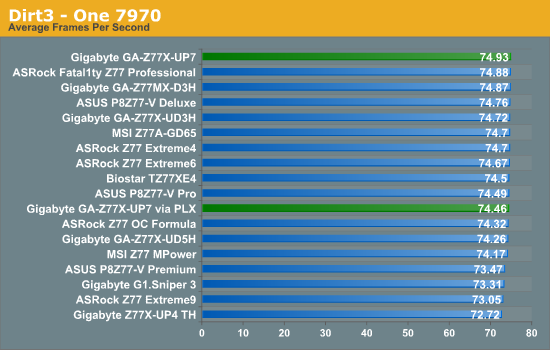
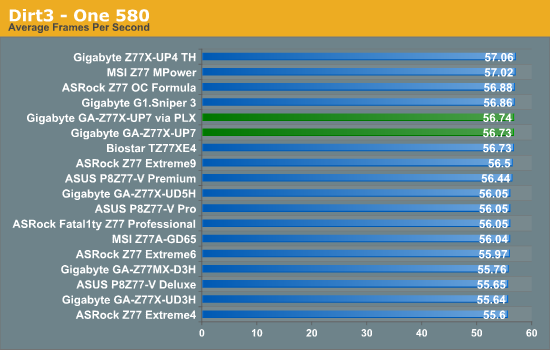
Again the PLX chip causes a minor hit to overall performance, as shown by the 1.97% drop on single card AMD (74.93 FPS to 73.46 FPS), but not so on NVIDIA (56.73-56.74 FPS) both with and without the PLX.
Other Benchmarks
As part of an upcoming update in our motherboard testing, we are moving towards newer drivers, and adding another couple of games to the test bed – Civilization V and Sleeping Dogs, both at 2560x1440 and all the graphical options turned right up. As we are not complete with this testing, we do not have any substantial tables to look through, though I do have Single GPU results on Catalyst 13.1 and NVIDIA 310.90 drivers for these games:
Civilization V:
- 86.43 FPS on HD7970
- 81.62 FPS on HD7970 via PLX
- 82.22 FPS on GTX580
- 80.40 FPS on GTX580 via PLX
Sleeping Dogs:
- 28.20 FPS on HD7970
- 27.98 FPS on HD7970 via PLX
- 16.10 FPS on GTX580
- 16.05 FPS on GTX580 via PLX
On all fronts the PLX chip causes a minor hit:
- Civ V: 5.57% on HD7970, 2.21% on GTX580
- Sleeping Dogs: 0.80% on HD7970, 0.31% on GTX580


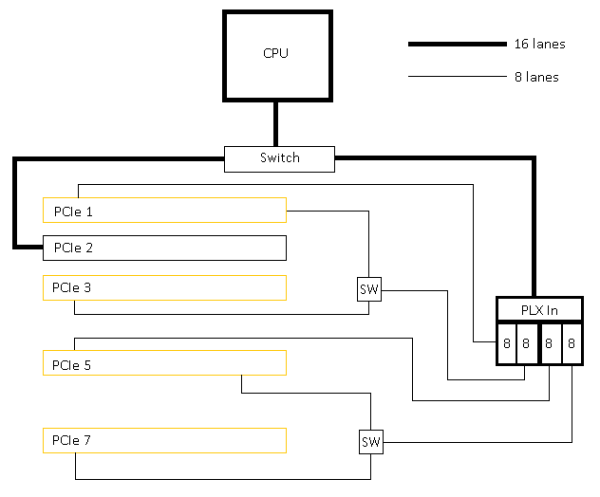








41 Comments
View All Comments
scaramoosh - Friday, March 1, 2013 - link
Why would you have the SLI x16s side by side? Space them out mobo manufacturers! Sick of it.IanCutress - Friday, March 1, 2013 - link
It's not side by side. As mentioned repeatedly and several times in the review, the PCIe x16 in black is used when one GPU is installed, and the orange slots are used when more than one PCIe device is in use. With two GPUs, you use the first and third orange slots at x16.Ian
scaramoosh - Friday, March 1, 2013 - link
That's as useless because it makes every other port on the board useless. I have 3 PCI-E x 1 devices and it basically means they sit right next to the cards getting hot.They need to have the x 16 spaced out at the top and then throw all the PCI-E x1s at the bottom.
IanCutress - Friday, March 1, 2013 - link
If any of the orange are populated the black x16 is disabled. You can still use the top x16 for a single GPU and put other devices in the other PCIe slots. If you have 3 PCIe x1 devices, this board is probably not aimed at your usage scenario - it's aimed at 3x and 4x GPU usage or multi-card with additional x8 RAID cards. There are plenty of other boards that have your usage scenario covered :)Ian
JeBarr - Friday, March 1, 2013 - link
Problem is, if you are a gamer looking to use 3x GPU and wish to add an audio card, ethernet card and PCIe storage card...out of luck. No such product exists. There are a few boards with enough slots but most cases will rob PCIe 3.0 lanes from one or two of the GPUsFlunk - Saturday, March 2, 2013 - link
That is because the standard ivy bridge CPU and chip set only have so many lanes. If you want more you'll need to move up to ivy bridge-e.Besides, no one really needs 3 GPUs, they just don't make games that need that amount of GPU processing power. The market is just too small. Heck, most games are console ports that will run at max settings on a GTX 460.
zenonu - Saturday, March 2, 2013 - link
Incorrect. You don't even need multiple monitors. It's not hard to max out dual 680s in SLI at 2560x1600 on modern games (Far Cry 3, Crysis 3) with complex outdoor environments.CeriseCogburn - Sunday, March 3, 2013 - link
I agree with zenonu, a Titan just tries to clear 1920X1200 single monitor, and it doesn't quite do it.A GTX 460 will get you by, not arguing that.
A 680 or 7970 doesn't cover 1920X1080 single monitor - it's dial down time.
Uber_Roy - Wednesday, March 6, 2013 - link
You sir have obviously not played Crysis 3 lately! Im waiting for the Nvidia 800 series or AMD 8000 series to max this game out, My two 7970s a i7 3930k@4ghz and 16gb of ram does not even play this game on high setting well let alone the Ultra high settingSabresiberian - Friday, March 1, 2013 - link
I so much agree here. Mainboard manufacturers just don't think in terms of an enthusiast that truly wants excellence on all fronts. This isn't helped by Intel, which has decided on-die graphics capabilities are more important than adding more PCI lanes, apparently. That's all good for those not interested in a separate graphics solution, but it's worthless to me.Really, I want 3 fully functional PCIe 3 slots (x16 on all of them, loaded up) and a fourth for a RAID controller, that doesn't gimp my graphics solution, and a PCIe 1 slot for a sound card. I really don't think that's too much to ask for in today's computing enthusiast world.
Stop spending my money by adding a half-ass sound daughter card, and let me install the sound solution I want!
I've been thinking I'll replace my x58 rig with a Haswell one, but I haven't heard anything about PCI lanes - and where's Thunderbolt support? Thunderbolt could feasibly go a long way to help people like me, I think.